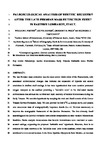PALEOECOLOGICAL ANALYSIS OF BENTHIC RECOVERY AFTER THE LATE PERMIAN MASS EXTINCTION EVENT IN EASTERN LOMBARDY, ITALY
| dc.contributor.author | Foster, W | |
| dc.contributor.author | Danise, S | |
| dc.contributor.author | Price, GD | |
| dc.contributor.author | Twitchett, RJ | |
| dc.date.accessioned | 2018-03-26T12:26:02Z | |
| dc.date.issued | 2018-06-12 | |
| dc.identifier.issn | 0883-1351 | |
| dc.identifier.issn | 1938-5323 | |
| dc.identifier.uri | http://hdl.handle.net/10026.1/11171 | |
| dc.description.abstract |
The late Permian mass extinction was the most severe biotic crisis of the Phanerozoic, with associated environmental changes that included the expansion of hypoxic and anoxic conditions in shallow shelf settings. It has been hypothesized that wave aeration promoted oxygen transport to the seafloor providing a ‘habitable zone’ in the shallowest marine environments that allowed the survival and rapid recovery of benthic invertebrates during the Early Triassic. We test this hypothesis by studying the rock and fossil records of the Lower Triassic Servino Formation, Italy. We also provide the first d13Ccarb isotope curve, and present new occurrence data of stratigraphically important fossils (i.e., cf. Tirolites cassianus), to improve the stratigraphic framework of the Servino Formation. The low-diversity fossil assemblages of the Servino Formation have similar compositions to other western Paleotethyan localities. Facies analysis demonstrates that benthic invertebrates were restricted to wave-aerated settings, supporting the proposed ‘habitable zone’ hypothesis. However, there is no evidence for rapid recovery in the ‘habitable zone’ prior to the Spathian, which may indicate additional environmental stresses. In the lower Spathian Myophoria Beds Member, an increase in taxonomic and functional richness, the appearance of stenohaline, erect taxa, significant turnover, and increased heterogeneity in the composition of benthic assemblages indicate significant benthic recovery, which is attributed to reduced environmental stress. Prior to the late Spathian ‘‘Upper Member’’, bioturbation is poorly developed and restricted to only a few thin horizons, but in the ‘‘Upper Member’’ the intensity of bioturbation and proportion of bioturbated rock increase. This change can be attributed to climatic cooling and a related decrease in environmental stress. This upper Spathian recovery pulse can now be traced across the western Paleotethys, in both nearshore and deep offshore (below wave base) settings. | |
| dc.format.extent | 266-281 | |
| dc.language | en | |
| dc.language.iso | en | |
| dc.publisher | Society for Sedimentary Geology | |
| dc.subject | 3709 Physical Geography and Environmental Geoscience | |
| dc.subject | 31 Biological Sciences | |
| dc.subject | 3103 Ecology | |
| dc.subject | 37 Earth Sciences | |
| dc.subject | 3702 Climate Change Science | |
| dc.subject | 3705 Geology | |
| dc.subject | 14 Life Below Water | |
| dc.title | PALEOECOLOGICAL ANALYSIS OF BENTHIC RECOVERY AFTER THE LATE PERMIAN MASS EXTINCTION EVENT IN EASTERN LOMBARDY, ITALY | |
| dc.type | journal-article | |
| dc.type | Article | |
| plymouth.author-url | https://www.webofscience.com/api/gateway?GWVersion=2&SrcApp=PARTNER_APP&SrcAuth=LinksAMR&KeyUT=WOS:000435368600003&DestLinkType=FullRecord&DestApp=ALL_WOS&UsrCustomerID=11bb513d99f797142bcfeffcc58ea008 | |
| plymouth.issue | 6 | |
| plymouth.volume | 33 | |
| plymouth.publication-status | Published | |
| plymouth.journal | PALAIOS | |
| dc.identifier.doi | 10.2110/palo.2017.079 | |
| plymouth.organisational-group | /Plymouth | |
| plymouth.organisational-group | /Plymouth/Faculty of Science and Engineering | |
| plymouth.organisational-group | /Plymouth/Faculty of Science and Engineering/School of Geography, Earth and Environmental Sciences | |
| plymouth.organisational-group | /Plymouth/REF 2021 Researchers by UoA | |
| plymouth.organisational-group | /Plymouth/REF 2021 Researchers by UoA/UoA07 Earth Systems and Environmental Sciences | |
| plymouth.organisational-group | /Plymouth/Research Groups | |
| plymouth.organisational-group | /Plymouth/Research Groups/Marine Institute | |
| plymouth.organisational-group | /Plymouth/Users by role | |
| plymouth.organisational-group | /Plymouth/Users by role/Academics | |
| plymouth.organisational-group | /Plymouth/Users by role/Researchers in ResearchFish submission | |
| dcterms.dateAccepted | 2018-03-21 | |
| dc.rights.embargodate | 2018-7-10 | |
| dc.identifier.eissn | 1938-5323 | |
| dc.rights.embargoperiod | Not known | |
| rioxxterms.funder | Natural Environment Research Council | |
| rioxxterms.identifier.project | The evolution of modern marine ecosystems: environmental controls on their structure and function | |
| rioxxterms.versionofrecord | 10.2110/palo.2017.079 | |
| rioxxterms.licenseref.uri | http://www.rioxx.net/licenses/all-rights-reserved | |
| rioxxterms.type | Journal Article/Review | |
| plymouth.funder | The evolution of modern marine ecosystems: environmental controls on their structure and function::Natural Environment Research Council |


